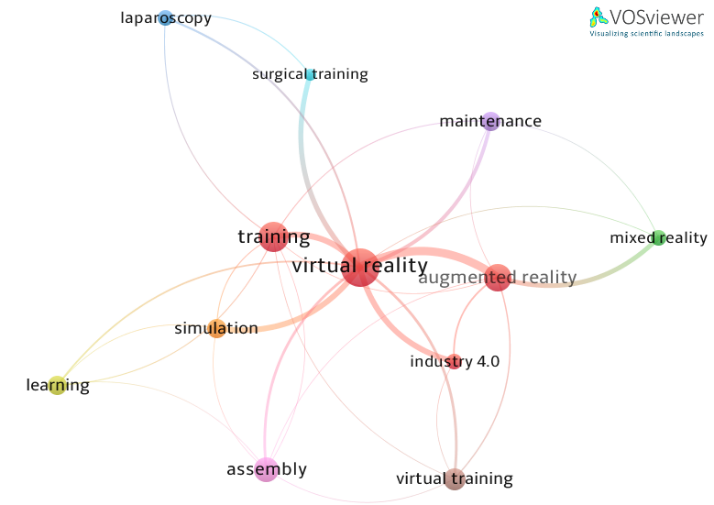A review of virtual reality videogames for job-training applications
DOI:
https://doi.org/10.33131/24222208.346Keywords:
Serious Game, Virtual Reality, Job Trainning, videogamesAbstract
Information and Communication Technologies (ICT) are considered as crucial elements in educational processes, as they constitute relevant and necessary tools in the search for higher levels of socioeconomic development. In this context, ICTs have raised the challenge of finding pedagogical models that maximize their impact on teachers and students. The Business Services and Management Center of the SENA Regional Antioquia has a wide range of technical training programs, for a rapid immersion into the labor market, which implies the use of training technologies to ease the understanding of theoretical concepts and the practice of technical procedures. In addition, these programs require the development of skills allowing their students to perform correctly in the workplace. Considering the above, videogames arise as an alternative tool for training operations. This article presents a review of training tools based on virtual reality, focusing mainly on the design of the game elements and their dynamics, which can contribute to magnify user experiences. Moreover, we present some projects showing success stories in the learning process and discussing the impact of the elements and game mechanics.
Downloads
References
F. J. Pérez Martínez, “Presente y futuro de la tecnología de la realidad virtual,” Creat. Soc., vol. XVI, pp. 1–39, 2011.
G. Vera Ocete, J. A. Ortega Carrillo, and M. Á. Burgos González, “La realidad virtual y sus posibilidades didácticas,” Etic Net, no. 2, p. 12, 2003.
O. Allal Chérif and M. Bidan, “Collaborative open training with serious games: Relations, culture, knowledge, innovation, and desire,” J. Innov. Knowl., vol. 2, no. 1, pp. 31–38, 2017.
M. C. DOrnellas, D. J. Cargnin, and A. L. C. Prado, “Thoroughly Approach to Upper Limb Rehabilitation Using Serious Games for Intensive Group Physical Therapy or Individual Biofeedback Training,” in 2014 Brazilian Symposium on Computer Games and Digital Entertainment, 2014, pp. 140–147.
J. Leder, T. Horlitz, P. Puschmann, V. Wittstock, and A. Schütz, “Comparing immersive virtual reality and powerpoint as methods for delivering safety training: Impacts on risk perception, learning, and decision making,” Saf. Sci., vol. 111, pp. 271–286, Jan. 2019.
J. C. Morales Saldarriaga, K. Fernández Morales, and J. E. Pulido, “Evaluación de técnicas de producción accesible en cursos masivos, abiertos y en línea - MOOC,” Rev. CINTEX, vol. 21, no. 1, pp. 89–112, 2016.
J. J. Castro-Maldonado, J. A. Patiño-Murillo, A. E. Florian-Villa, and O. E. Guadrón-Guerrero, “Application of computer vision and low-cost artificial intelligence for the identification of phytopathogenic factors in the agro-industry sector,” J. Phys. Conf. Ser., vol. 1126, p. 012022, Nov. 2018.
H. D. Ortiz Alzate, L. G. Muñoz Marín, J. Cardeño Espinosa, and N. C. Alzate Osorno, “Impacto del uso de objetos interactivos de aprendizaje en la apropiación de conocimiento y su contribución en el desarrollo de competencias matemáticas: un resultado de experiencia de investigación,” Rev. CINTEX, vol. 21, no. 1, pp. 71–88, jun. 2016.
C. Hernandez, D. Velez, and J. A. Isaza, “Diseño de una plataforma de prueba de sensores virtuales para el sistema glucosa-insulina de pacientes UCI usando la técnica HIL,” Rev. CINTEX, vol. 23, no. 2, pp. 61–75, Dec. 2018.
A. Peralta and F. P. Romero, “Toma de Decisiones a partir de Conocimiento Extraído tras el Análisis de Comportamientos Previos. Aplicación Práctica para la Dirección de Proyectos de Desarrollo de Software,” Rev. CINTEX, vol. 20, no. 2, pp. 97–111, 2015.
J. J. Castro Maldonado, J. A. Patiño Murillo, and C. Gómez López, “Procesos de I+D+i en el Centro de Servicios y Gestión Empresarial del Servicio Nacional de Aprendizaje SENA 2015-2017,” Rev. Espac., vol. 39, no. 20, p. 21, 2018.
E. Zapa Pérez, “Impacto de la Gestión por Procesos en la Innovación de las Organizaciones,” Rev. CINTEX, vol. 19, pp. 23–37, 2014.
B. Kitchenham, “Procedures for Performing Systematic Literature Reviews,” 2004.
Oculus VR, “Walmart Expands VR Training with Oculus Go | Oculus,” 2018.
J. Brustein, “Microsoft gana un contrato de $ 480 millones para el campo de batalla del ejército - Bloomberg,” 2018.
J. A. Nayhua Gamarra and R. A. Guzmán Neyra, “Uso de Realidad Virtual Inmersiva (RVI) para el entrenamiento de personal en Seguridad, mantenimiento y operaciones.” pp. 1–18, 2018.
E. G. G. Verdaasdonk, L. P. S. Stassen, M. P. Schijven, and J. Dankelman, “Construct validity and assessment of the learning curve for the SIMENDO endoscopic simulator,” Surg. Endosc., vol. 21, no. 8, pp. 1406–1412, Jul. 2007.
A. Maciel, L. Youquan, W. Ahn, and P. Singh, “Towards a virtual basic laparoscopic skill trainer. | Center for Modeling, Simulation, & Imaging in Medicine (VBLaST,” Stud. Health Technol. Inform., vol. 132, pp. 275–80, 2008.
L. Zhang et al., “The added value of virtual reality technology and force feedback for surgical training simulators.,” Work Read. Mass, vol. 41 Suppl 1, pp. 2288–92, 2012.
P. Lamata et al., “SINERGIA laparoscopic virtual reality simulator: Didactic design and technical development,” Comput. Methods Programs Biomed., vol. 85, no. 3, pp. 273–283, Mar. 2007.
Consorcio OPENSURG, Robótica médica: Notas prácticas para el aprendizaje de robótica en bioingeniería, consorcio OPENSURG. 2012.
A. Nasr, J. T. Gerstle, B. Carrillo, and G. Azzie, “The Pediatric Laparoscopic Surgery (PLS) simulator: Methodology and results of further validation,” J. Pediatr. Surg., vol. 48, no. 10, pp. 2075–2077, Oct. 2013.
E. Salas and M. E. Gregory, “A Medical VR Simulator in Laparoscopic Rectum Surgery,” 2014.
L. A. Ospina Ospina and J. F. Escobar Soto, “La simulación como estrategia pedagógica y didáctica en la formación integral en el SENA,” in III Simposio Nacional de Formación con Calidad y Pertinencia, 2016.
C. M. López Gutiérrez and J. P. Arias Herrera, Oscar Arnmando Giraldo Escobar, “Entrenamiento Interactivo (3D) en Redes de Distribución de Energía Eléctrica | Megavatios,” Megavatios, 2018.
D. Grajewski et al., “Improving the Skills and Knowledge of Future Designers in the Field of Ecodesign Using Virtual Reality Technologies,” in Procedia Computer Science, 2015, vol. 75, pp. 348–358.
G. Sankaranarayanan et al., “Validation of a novel laparoscopic adjustable gastric band simulator,” Surg. Endosc., vol. 25, no. 4, pp. 1012–1018, Apr. 2011.
D. W. Carruth, “Virtual reality for education and workforce training,” in ICETA 2017 - 15th IEEE International Conference on Emerging eLearning Technologies and Applications, Proceedings, 2017.
L. Chittaro, C. L. Corbett, G. A. McLean, and N. Zangrando, “Safety knowledge transfer through mobile virtual reality: A study of aviation life preserver donning,” Saf. Sci., vol. 102, pp. 159–168, Feb. 2018.
S. Londoño Marín, J. A. Londoño Gallego, J. J. Castro Maldonado, and J. A. Patiño Murillo, “Guía interactiva para el desarrollo de proyectos bajo la Metodología de Marco Lógico,” Rev. Espac., vol. 39, no. 47, p. 25, 2018.
Y. Shi, J. Du, C. R. Ahn, and E. Ragan, “Impact assessment of reinforced learning methods on construction workers’ fall risk behavior using virtual reality,” Autom. Constr., vol. 104, pp. 197–214, Aug. 2019.
T. Haase and W. Termath, “A Virtual Interactive Training Application for Supporting Service Technicians in the Field of High Voltage Equipment,” in Procedia Computer Science, 2015, vol. 77, pp. 207–214.
B. Z. Roitberg, P. Kania, C. Luciano, N. Dharmavaram, and P. Banerjee, “Evaluation of Sensory and Motor Skills in Neurosurgery Applicants Using a Virtual Reality Neurosurgical Simulator: The Sensory-Motor Quotient,” J. Surg. Educ., vol. 72, no. 6, pp. 1165–1171, 2015.
S. Kavanagh, A. Luxton-Reilly, B. Wuensche, and B. Plimmer, “A Systematic Review of Virtual Reality in Education.,” Themes Sci. Technol. Educ., vol. 10, no. 2, pp. 85–119, 2017.
B. A. J. Menelas, C. Haidon, A. Ecrepont, and B. Girard, “Use of virtual reality technologies as an Action-Cue Exposure Therapy for truck drivers suffering from Post-Traumatic Stress Disorder,” Entertain. Comput., vol. 24, pp. 1–9, Jan. 2018.
J. J. Roldán, E. Crespo, A. Martín-Barrio, E. Peña-Tapia, and A. Barrientos, “A training system for Industry 4.0 operators in complex assemblies based on virtual reality and process mining,” Robot. Comput. -Integr. Manuf., vol. 59, pp. 305–316, Oct. 2019.
P. A. Winkes and J. C. Aurich, “Method for an enhanced assembly planning process with systematic virtual reality inclusion,” in Procedia CIRP, 2015, vol. 37, pp. 152–157.
M. A. Rizzuto, M. W. L. Sonne, N. Vignais, and P. J. Keir, “Evaluation of a virtual reality head mounted display as a tool for posture assessment in digital human modelling software,” Appl. Ergon., vol. 79, pp. 1–8, Sep. 2019.
S. Tretsiakova-McNally, E. Maranne, F. Verbecke, and V. Molkov, “Mixed e-learning and virtual reality pedagogical approach for innovative hydrogen safety training of first responders,” Int. J. Hydrog. Energy, vol. 42, no. 11, pp. 7504–7512, Mar. 2017.
J. Cecil, A. Gupta, M. Pirela-Cruz, and P. Ramanathan, “An IoMT based cyber training framework for orthopedic surgery using Next Generation Internet technologies,” Inform. Med. Unlocked, vol. 12, pp. 128–137, Jan. 2018.
A. Bernardo, “Virtual Reality and Simulation in Neurosurgical Training,” World Neurosurg., vol. 106, pp. 1015–1029, Oct. 2017.
A. Karvouniari, G. Michalos, N. Dimitropoulos, and S. Makris, “An approach for exoskeleton integration in manufacturing lines using Virtual Reality techniques,” in Procedia CIRP, 2018, vol. 78, pp. 103–108.
R. A. Kockro et al., “Aneurysm Surgery with Preoperative Three-Dimensional Planning in a Virtual Reality Environment: Technique and Outcome Analysis,” World Neurosurg., vol. 96, pp. 489–499, Dec. 2016.
Å. Fast-Berglund, L. Gong, and D. Li, “Testing and validating Extended Reality (xR) technologies in manufacturing,” in Procedia Manufacturing, 2018, vol. 25, pp. 31–38.
V. G. G. Freitas, A. Carlos De Abreu Mol, and R. Shirru, “Virtual reality for operational procedures in radioactive waste deposits,” Prog. Nucl. Energy, vol. 71, pp. 225–231, Mar. 2014.












